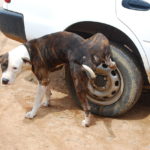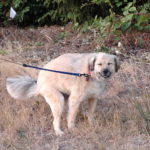As dogs cannot converse with us in human languages, it is important that we, pet’s parents, make an effort to observe our dogs. Similar to the need to observe our dog’s poop, we should also observe our dog’s body language in order to understand their emotional state and their intention. Body language is a form of non-verbal communication which we use heavily in our daily life. We do so with the use of facial expressions, body posture, gestures, eye movement, touch and the use of space to convey information. Similarly for dogs, they uses body language to converse with us as well. Read on to find out how to read your dog’s body language.
How to read your dog’s body language
To have a holistic understanding of the message our dog wants to convey, we have to pay attention to all aspect of our dog’s body language. This means we should observe our dog’s tail, stance, eyes, ears and mouth. However, do remember that your dog is unique. The following information acts as a guide only. If your dog’s body language does not fit to the below descriptions, it could be that your dog have a different body language vocabulary.
Tail
Tail wagging is commonly used as a gauge of a dog’s mood or state. For instant, we might interpret that our dog is friendly (state) or happy (mood) when they wag their tail. But this isn’t always the case! Instead, tail wagging is a sign of their willingness to interact. A wagging tail indicates that our dog is open to interaction, rather than their level of friendliness. In other words, a wagging tail signals that our dog is mentally aroused and engaged, instead of how he will react. Used together with facial expressions and body postures to understand how our dog feels beyond it’s readiness to interact! So what information can we derive from our dog’s tail?
Tail height
Let’s start by looking at how your dog position it’s tail. A wagging tail held high usually reflects enthusiasm or confidence. However if the tip of the tail is also held high, this could be an indication that your dog is challenging your authority. On the contrary, a wagging tail that is held lower could reflect that your dog is nervous, timid, confused or relaxed. In order to make a better judgment of what signal your dog is delivering, check out the 2 other factors below.
Tail stiffness
How relax is your dog’s tail? A loose swaying tail usually indicates that he is relax while a stiff tail shows sign of hostility or a high degree of alertness.
Tail Speed
If your dog wags his tail at a fast pace, it signals that your dog is friendly while a slow wagging tail indicates the contrary.
Do keep in mind that a wagging tail have different meanings in different situation or when used in the context of different dogs. Hence, we have to consider other aspect of our dog’s body language as well!
Stance
You can also derive significant information about your dog by examining his posture. Dogs which are in a relax state tend to adopt a loose stance with weight evenly balanced on all four feet. In a playful state, he will like adopt the stance of a relax state but with an added bounciness; he will probably be bouncing or running around with exaggerated movements.
On the contrary frightened dogs show their fear by lowering their body, sometimes to the extend of cowering on the ground or holding his head low. If your dog is frightened by something, he will recoil away from it. A submissive dog reacts similarly to frightened dog – he lowers his body or cower on the ground!
Dogs that are dominant often adopt a stiff-legged stance with their body leaning slightly forward. For dogs that are in a state of alertness sometimes even stand on their toes while leaning slightly forward, with his neck and head raised above his shoulders. Be wary! An aggressive dog’s stance looks similar to dominant or alert dogs but is accompanied by aggressive threats, for instance charging forward rapidly.
Eyes
Your dog’s eye can vary in shape and size or the direction and intensity of his gaze. When feeling threatened , his eye will appear wider than usual. If his eyes are wide open and alert, this means he is paying attention to you and wants you to give him your attention as well. An aggressive dog on the other hand have eyes that are narrow with a threatening glaze. Having said so, when your dog eyes seem smaller than usual, it does not necessarily means he is aggressive. This could indicate that he is feeling frightened or stressed. Do pay extra attention to your dog if he is seen squinting his eyes as this is an indication that he is not feeling well or is in pain.
Do you face the issue whereby your dog doesn’t directly into your eyes? My shih tzu doesn’t look at me which puzzled me. Hence I did a research and learn that dog considers it as a threatening behavior to look directly into each others eyes! However, some dogs learn that it’s okay to look directly at people. Do note that there is a difference when you dog looks at your with a relax or tense facial expression. A relax expression means your dog is being friendly and is hoping for your attention while a tense expression is likely to be a threat; slowly look away, this is what dogs do as well when they don’t want to appear threatening. When your dog look away when you look at him, he is signalling that he is submissive or scare; this could be seen in situation where he did something wrong and is worried of an upcoming punishment. If your dog looks out of the corners of his eyes – also known as ‘whale eye’ – and appearing rigid or tense, this is an indication that he might lead up to an aggressive outburst. This is usually seen when he is guarding his toy.
Ear
 Different dog have different types of ear which dictate how he can use them to convey a message. At a relax state, he will hold his ears naturally. When he is curious and exploring a new environment or when he is alert or feeling aggressive, his ears would probably be standing straight up. When his ears are pulled back flat against the head, he is signalling that he is frightened or feeling submissive.
Different dog have different types of ear which dictate how he can use them to convey a message. At a relax state, he will hold his ears naturally. When he is curious and exploring a new environment or when he is alert or feeling aggressive, his ears would probably be standing straight up. When his ears are pulled back flat against the head, he is signalling that he is frightened or feeling submissive.
Mouth
Although we cannot understand what our dogs are saying when they bark, we could however observe how they position their lips, jaws and teeth to derive a wealth of information. A neutral state is when they have their mouth closed or slightly open; this is when they are feeling relaxed and happy. If he open his mouth – often also accompanied with his tongue sticking out – he may be panting and trying to cool down. When frightened, your dog’s mouth is likely closed with his lips slightly pulled back at the corners. This could also be an indication that he is feeling submissive; he might lick you if he is interacting with you. A dog may draw his lips back horizontally, displaying both his front and back teeth to indicate fear. However, if he pulls his lips up and mouth open, this may be a sign that he is ready to bite. Beware if your dog is seen pulling his lips up vertically, displaying his front teeth while wrinkling the top of his muzzle – this is a sign that your dog is warning you not to come closer.






